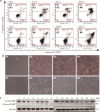Polyphyllin I enhances tumor necrosis factor-related apoptosis-inducing ligand-induced inhibition of human osteosarcoma cell growth downregulating the Wnt/β-catenin pathway
- PMID: 38504531
- PMCID: PMC10927409
- DOI: 10.19852/j.cnki.jtcm.2024.02.002
Polyphyllin I enhances tumor necrosis factor-related apoptosis-inducing ligand-induced inhibition of human osteosarcoma cell growth downregulating the Wnt/β-catenin pathway
Abstract
Objective: To investigate the synergistic effects of polyphyllin I (PPI) combined with tumor necrosis factor-related apoptosis-inducing ligand (TRAIL) on the growth of osteosarcoma cells through downregulating the Wnt/β-catenin signaling pathway.
Methods: Cell viability, apoptosis and cell cycle distribution were examined using cell counting kit-8 and flow cytometry assays. The morphology of cancer cells was observed with inverted phase contrast microscope. The migration and invasion abilities were examined by xCELLigence real time cell analysis DP system and transwell assays. The expressions of poly (adenosine diphosphate-ribose) polymerase, C-Myc, Cyclin B1, cyclin-dependent kinases 1, N-cadherin, Vimentin, Active-β-catenin, β-catenin, p-glycogen synthase kinase 3β (GSK-3β) and GSK-3β were determined by Western blotting assay.
Results: PPI sensitized TRAIL-induced decrease of viability, migration and invasion, as well as increase of apoptosis and cell cycle arrest of MG-63 and U-2 OS osteosarcoma cells. The synergistic effect of PPI with TRAIL in inhibiting the growth of osteosarcoma cells was at least partially realized through the inactivation of Wnt/β-catenin signaling pathway.
Conclusion: The combination of PPI and TRAIL is potentially a novel treatment strategy of osteosarcoma.
Keywords: Wnt signaling pathway; beta-catenin; osteosarcoma; polyphyllin I; tumor necrosis factor-related apoptosis-inducing ligand.
Figures




References
MeSH terms
Substances
Grants and funding
- 2020YFE0201600/National Key R & D Program of China: Cooperating Studies on Measurement Technologies of Human Phenome and Cross-scale Correlation of Phenotypic Data
- 81973877/National Nature Science Foundation: Study on LncRNA-CCDC18-AS1 Mediated Osteosarcoma Occurrence by Activating YAP/TAZ and Tumor Microenvironment M2 TAM-dependent Lung Metastasis, and Efficacy/mechanism of Removing Blood Stasis/clearing heat/eliminating Toxic Material Principle
- 82174408/National Nature Science Foundation: Mechanism Study on m6A Methyltransferase RBM15 Mediated YAP Epigenetic Modification to Promote Osteosarcoma Lung Metastasis through Lymphatic System and Management with Qichong Powder
- 2021LK047/Research Projects within Budget of Shanghai University of Traditional Chinese Medicine: the Research on the Mechanism of the HIPK3 Activation of Wnt/β-catenin Induction the Osteosarcoma and the Intervention of Banmao Decoction
LinkOut - more resources
Full Text Sources
Medical
Research Materials
